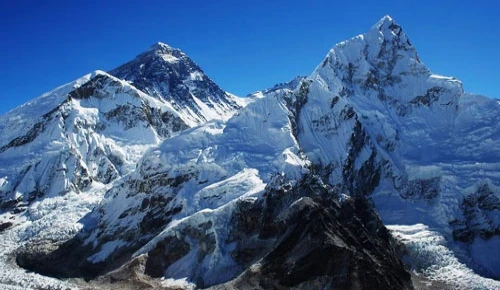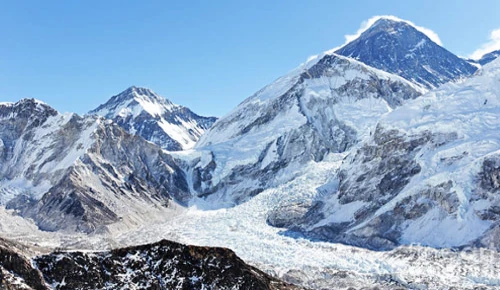Wildlife of Everest Region
The Everest Base Camp trek is more than just a physical expedition; it's a captivating adventure that reveals the untouched wonders of nature. Beyond the majestic peaks and breathtaking landscapes, this trek offers a unique chance to connect with the diverse wildlife of the Himalayas. Explore the unseen gifts of nature and venture into pristine realms where the wild and mystical meet.
Join us in this blog for a vivid exploration of the fascinating wildlife encounters awaiting you on your Khumbu region journey.
Table of Contents
Himalayan Tahr

- Appearance: large, goat-like ungulate with a distinctive white beard, black facial markings, and a dark brown coat. Large, backward-curving horns up to 1.5 meters long.
- Habitat: High Himalayas, 3,000 to 5,500 meters. Rocky terrain, alpine meadows
- Behavior: social animals, herds of up to 12. Most active in the morning and evening, grazing and resting.
- Unique Fact: largest wild goat in the world.
Encounters: Spotted often around Namche Bazaar and the lush alpine meadows near Gokyo Lake, as well as the rocky landscapes near Tengboche and the dense forests around Dingboche, specifically in the area known as "Ama Dablam Base Camp Forest."
Ruddy Shelduck

- Appearance: medium-sized waterfowl with distinctive rust-orange plumage, a white ring around the eye, and a black beak. Males and females share similar coloring.
- Habitat: Found in various wetland habitats, including lakes, ponds, and rivers. Altitude ranges from lower elevations to higher Himalayan regions.
- Behavior: social birds, often seen in pairs or small flocks. Known for their distinctive call, a series of whistles and quacks. Diurnal, active during the day.
- Unique Fact: Ruddy Shelducks are known for their strong pair bonds, often forming monogamous pairs that last for several breeding seasons.
Encounters: Frequently spotted around the serene lakes of Gokyo, where their vibrant plumage creates a striking contrast against the crystal-clear waters. Additionally, sightings near the riverbanks along the trekking route, especially around areas like Phakding and Namche Bazaar, are not uncommon.
Yak: The Everest Icon

- Appearance: robust build, shaggy hair, humped shoulders, and curved horns.
- Habitat: Flourishes at 3,000 to 5,500 meters in the Everest region.
- Unique facts: contribute to local cuisine and stand as iconic companions in the high-altitude tapestry of the Himalayas.
Encounters: Encountered in Dingboche's lush meadows and the high-altitude terrains near Lobuche.
Musk Deer

- Appearance: small, deer-like, with a reddish-brown coat, a long bushy tail, and short pointed horns. Musk gland under the tail
- Habitat: forests and alpine meadows, 2,500 to 4,500 meters.
- Behavior: Solitary, active at dawn and dusk. Shy and rarely seen.
- Unique Fact: Only deer species have no antlers.
Encounters: Sighted in the dense forests near Tengboche, particularly around the area known as "Debuche Forest," and often glimpsed around the serene landscapes of Dingboche, specifically in the region known as "Imja Valley."
Snow Leopard

- Appearance: large, cat-like predator with grayish-white fur, black rosettes, and a long tail. Pointed ears and yellow eyes.
- Habitat: High Himalayas, 3,000 to 6,500 meters. Rocky terrain for hunting and stalking prey
- Behavior: Solitary, most active at dawn and dusk. Stealthy predators ambush prey like ibex, blue sheep, and wild boar.
- Unique Fact: The highest-living cat species in the world
Encounters: Elusive, but signs of their presence noted around the rugged landscapes near Lobuche and the upper reaches of the Khumbu Valley, particularly around the area known as "Thokla Pass."
Himalayan Monal

- Appearance: large, pheasant-like bird with colorful plumage. Bright blue head, green back, and golden breast. Long, flowing tail with black and white stripes.
- Habitat: forests and alpine meadows, 3,000 to 4,500 meters.
- Behavior: social bird, flocks of up to 20. Most active in the morning and evening, foraging and singing.
- Unique Fact: The national bird of Nepal
Encounters: Often seen gracing the skies near Tengboche and adding a burst of color to the picturesque landscapes around Pangboche, specifically in the area known as "Ama Dablam Viewpoint."
Tibetan Snowcock

- Appearance: medium-sized, grouse-like bird with mottled gray and white plumage. Short, black tail and a red patch around the eyes.
- Habitat: High Himalayas, 3,500 to 5,500 meters. Rocky terrain, alpine meadows
- Behavior: Solitary, most active during the day. Ground-feeding, foraging for seeds, insects, and small mammals.
- Unique Fact: This is one of the few birds that can survive at altitudes above 5,000 meters.
Encounters: Spotted gracefully navigating the rocky landscapes near Cho La Pass and the expansive meadows around Gokyo Lake, specifically in the region known as "Renjo La Pass."
Blood Pheasant

- Appearance: large, pheasant-like bird with bright red plumage. It has a long black tail and a distinctive red crest on its head.
- Habitat: Forests of the Everest region, 2,500 to 4,000 meters. Prefers dense forests with plenty of undergrowth.
- Behavior: Solitary, most active at dawn and dusk. Ground-feeding, foraging for seeds, insects, and small mammals.
- Unique Fact: Only pheasant species native to Nepal.
Encounters: Frequently sighted in the lush forests around Namche Bazaar, specifically in the area known as "Namche Forest," and the dense vegetation near Tengboche, particularly in the region known as "Rhododendron Sanctuary."
Grandala

- Appearance: Medium-sized, horned ungulate with grayish-brown coat. Long, slender horns and a white stripe on its face.
- Habitat: High Himalayas, 4,000 to 6,000 meters. Alpine meadows and rocky terrain
- Behavior: social animals, herds of up to 100. Most active during the day, grazing on grass, herbs, and lichens.
- Unique Fact: Only ungulate species known to breed at altitudes above 6,000 meters.
Encounters: Frequently seen in the expansive meadows of Gorak Shep and the rocky landscapes around Kala Patthar, specifically in the region known as "Everest Base Camp Approach."
Spotted Nutcracker

- Appearance: medium-sized, corvid bird with black and white plumage. Long, curved bill and a white spot on its wing.
- Habitat: High Himalayas, 3,000 to 5,000 meters. Prefers coniferous forests with plenty of pine cones.
- Behavior: intelligent bird, known for caching food. Stores up to 10,000 pine cones in a single season.
- Unique Fact: Thrives in the harsh, high-altitude environment of the Himalayas.
Encounters: Frequently observed in the pine-covered landscapes around Tengboche, particularly in the area known as "Tengboche Pine Forest," and the dense forests near Dingboche, specifically in the region known as "Dingboche Woodlands."
Golden Eagle

- Appearance: A large, eagle-like bird with a brown body and a golden head and neck. Long, powerful wingspan and sharp talons.
- Habitat: Mountains of Asia and Europe, 3,000 to 5,000 meters. Prefers to live in open areas with plenty of prey, such as rabbits, hares, and marmots.
- Behavior: Solitary predator, hunts a variety of prey. Most active during the day, uses its sharp vision to spot prey from a distance.
- Unique Fact: One of the largest and most powerful eagles in the world.
Encounters: Soaring high above the mountainous landscapes, often seen around the rugged terrains near Lobuche and the open spaces around Gokyo Lake, specifically in the region known as "Gokyo Eagle Watchpoint."
Red Panda

- Appearance: Small mammal with reddish-brown fur, a long bushy tail, and distinctive black face and ears. Balances in trees with a curved, ringed tail.
- Habitat: Thrives in high Himalayas, 2,000 to 4,000 meters. Prefers dense bamboo forests. Spotted in Everest region hotspots like Sherpaland Wildlife Sanctuary, Langtang National Park, and Makalu Barun National Park.
- Behavior: Solitary and arboreal, most active at dawn and dusk. Shy by nature, sustains on bamboo leaves and shoots.
- Unique Fact: The only species in the Ailuridae family closely related to raccoons.
Encounters: Catch glimpses of the enchanting Sherpaland Wildlife Sanctuary, the pristine Langtang National Park, and the untouched beauty of Makalu Barun National Park.
Conclusion:
The Everest Base Camp Trek is not just about conquering peaks but immersing in the untamed beauty of the Himalayan wildlife. From the regal Himalayan Tahr to the vibrant Ruddy Shelducks and the iconic Yak, each encounter paints a vivid picture of resilience and harmony. As you traverse the alpine meadows, rocky terrains, and dense forests, remember that every step is a dance with the diverse and captivating creatures that call the Everest region home. Respect their presence, marvel at their uniqueness, and let their untold stories echo in the rhythm of your trek.








